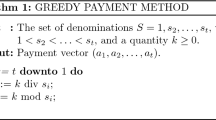Abstract
We investigate various problems related to circulant graphs — finding the shortest path between two vertices, finding the shortest loop, and computing the diameter. These problems are related to shortest vector problems in a special class of lattices. We give matching upper and lower bounds on the length of the shortest loop. We claim NP-hardness results, and establish a worst-case/average-case connection for the shortest loop problem. A pseudo-polynomial time algorithm for these problems is also given. Our main tools are results and methods from the geometry of numbers.
Supported in part by NSF grant CCR-9634665 and a J. S. Guggenheim Fellowship.
Supported in part by ARC grants A49702337 and A49801415.
Supported in part by NSF grant CCR-9634665.
Supported in part by ARC grant A69700294.
Access this chapter
Tax calculation will be finalised at checkout
Purchases are for personal use only
Preview
Unable to display preview. Download preview PDF.
Similar content being viewed by others
References
M. Ajtai. Generating hard instances of lattice problems. In Proc. 28th Annual ACM Symposium on the Theory of Computing (1996) 99–108.
M. Ajtai. The shortest vector problem in L 2 is NP-hard for randomized reductions. In Proc. 30th Annual ACM Symposium on the Theory of Computing (1998) 10–19.
M. Ajtai and C. Dwork. A public-key cryptosystem with worst-case/average-case equivalence. In Proc. 29th ACM Symposium on Theory of Computing (1997) 284–293.
S. Arora, L. Babai, J. Stern, and Z. Sweedyk. The hardness of approximate optima in lattices, codes, and systems of linear equations. In Proc. 34th IEEE Symposium on Foundations of Computer Science (FOCS), 724–733, 1993.
J.-C. Bermond, F. Comellas and D. F. Hsu. Distributed loop computer networks: A survey. Journal of Parallel and Distributed Computing 24 (1995) 2–10.
J-Y. Cai. A relation of primal-dual lattices and the complexity of shortest lattice vector problem. Theoretical Computer Science 207 (1998) 105–116.
J-Y. Cai and A. Nerurkar. An improved worst-case to average-case connection for lattice problems. In Proc. 38th IEEE Symposium on Foundations of Computer Science (1997) 468–477.
J-Y. Cai and A. Nerurkar. Approximating the SVP to within a factor \( \left( {1 + \frac{1} {{\dim ^ \in }}} \right) \) is NP-hard under randomized reductions. In Proc. 13th Annual IEEE Conference on Computational Complexity (1998) 46–55.
J. W. S. Cassels. An introduction to the geometry of numbers. Springer-Verlag, 1959.
N. Chalamaiah and B. Ramamurty. Finding shortest paths in distributed loop networks. Inform. Proc. Letters 67 (1998) 157–161.
Y. Cheng and F. K. Hwang. Diameters of weighted loop networks. J. of Algorithms 9 (1988) 401–410.
J. A. Dias da Silva and Y. O. Hamidoune. Cyclic spaces for Grassmann derivatives and additive theory Bull. Lond. Math. Soc. 26 (1994) 140–146.
I. Dinur, G. Kindler and S. Safra. Approximating-CVP to within almost-polynomial factors is NP-hard. 1998.
P. Erdös and H. Heilbronn On the addition of residue classes mod p Acta Arithm. 9 (1964) 149–159.
O. Goldreich and S. Goldwasser. On the limits of non-approximability of lattice problems. In Proc. 30th Annual ACM Symposium on the Theory of Computing (1998) 1–9.
O. Goldreich, S. Goldwasser and S. Halevi. Collision-free hashing from lattice problems. 1996. Available as TR96-042 from Electronic Colloquium on Computational Complexity at http://www.eccc.uni-trier.de/eccc/.
O. Goldreich, S. Goldwasser and S. Halevi. Eliminating decryption errors in the Ajtai-Dwork cryptosystem. Advances in Cryptology — CRYPTO '97 (editor B. Kaliski Jr.), Lecture Notes in Computer Science 1294 (Springer Verlag, 1997) 105–111.
O. Goldreich, S. Goldwasser and S. Halevi. Public-key cryptosystems from lattice reduction problems. Advances in Cryptology — CRYPTO '97 (editor B. Kaliski Jr.), Lecture Notes in Computer Science 1294 (Springer Verlag, 1997) 112–131.
D. J. Guan. Finding shortest paths in distributed loop networks. Inform. Proc. Letters 65 (1998) 255–260.
J. C. Lagarias. The computational complexity of simultaneous diophantine approximation problems. In Proc. 23rd IEEE Symposium on Foundations of Computer Science (1982) 32–39.
F. T. Leighton. Introduction to parallel algorithms and architectures: Arrays, trees, hypercubes. M. Kaufmann, 1992.
A. K. Lenstra, H. W. Lenstra and L. Lovász. Factoring polynomials with rational coefficients. Mathematische Annalen 261 (1982) 515–534.
B. Mans. Optimal Distributed algorithms in unlabeled tori and chordal rings. Journal on Parallel and Distributed Computing 46 (1997) 80–90.
D. Micciancio. The shortest vector in a lattice is hard to approximate to within some constant. In Proc. 39th IEEE Symposium on Foundations of Computer Science (1998) 92–98.
A. Paz and C. P. Schnorr. Approximating integer lattices by lattices with cyclic factor groups. Automata, Languages and Programming, 14th International Colloquium, Lecture Notes in Computer Science 267 (Springer-Verlag, 1987) 386–393.
R. Raz. Personal communication.
C. P. Schnorr. A hierarchy of polynomial time basis reduction algorithms. Theoretical Computer Science 53 (1987) 201–224.
J-P. Seifert and J. Blömer. On the complexity of computing short linearly independent vectors and short bases in a lattice. To appear in the proceedings of STOC 1999.
P. van Emde Boas. Another NP-complete partition problem and the complexity of computing short vectors in lattices. Technical Report 81-04, Mathematics Department, University of Amsterdam, 1981.
J. Žervonik and T. Pisanski. Computing the diameter in multi-loop networks. J. of Algorithms 14 (1993) 226–243.
Author information
Authors and Affiliations
Editor information
Editors and Affiliations
Rights and permissions
Copyright information
© 1999 Springer-Verlag Berlin Heidelberg
About this paper
Cite this paper
Cai, JY., Havas, G., Mans, B., Nerurkar, A., Seifert, JP., Shparlinski, I. (1999). On Routing in Circulant Graphs. In: Asano, T., Imai, H., Lee, D.T., Nakano, Si., Tokuyama, T. (eds) Computing and Combinatorics. COCOON 1999. Lecture Notes in Computer Science, vol 1627. Springer, Berlin, Heidelberg. https://doi.org/10.1007/3-540-48686-0_36
Download citation
DOI: https://doi.org/10.1007/3-540-48686-0_36
Published:
Publisher Name: Springer, Berlin, Heidelberg
Print ISBN: 978-3-540-66200-6
Online ISBN: 978-3-540-48686-2
eBook Packages: Springer Book Archive




